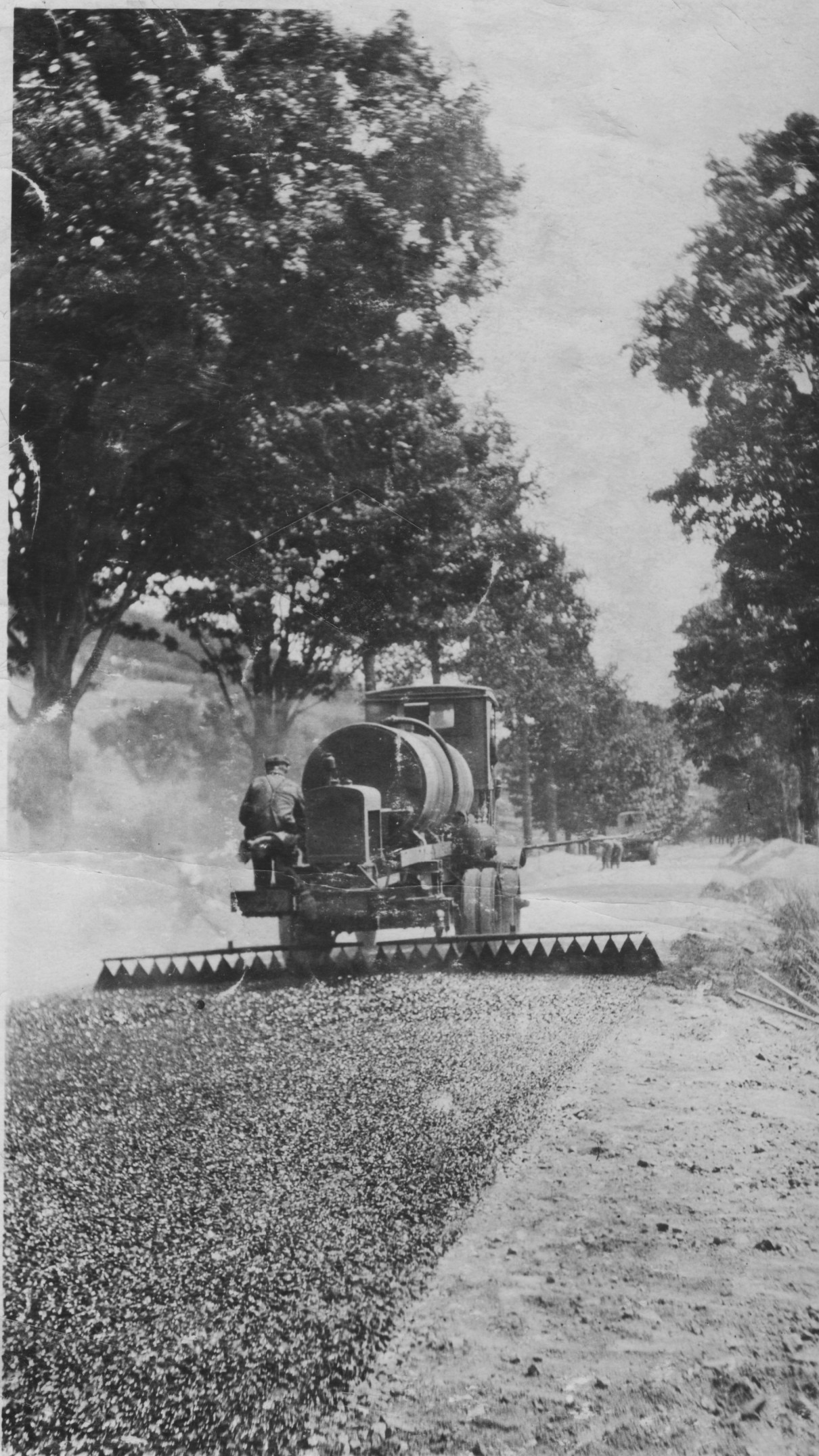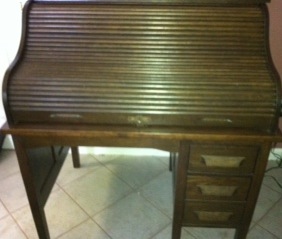
A Model F Heater and Distributor
Let's start with the unusual picture that I found in Harry's personal collection. It was unlike the other pictures that he had saved of his road construction work. Those pictures showed men working, and in some cases, Harry supervising. As far as I can determine, they were taken by Major Matthews and copies of the originals are in the Vancouver Archives. The picture of the Model F Heater above was a sales promotion picture (sort of like a post card) that was provided by a company named Etnyre and it is not part of the Vancouver Archives. With help from the Internet, I found that E. D. Etnyre and Company was founded in 1898. In the early 1900s, they sold horse-drawn water sprinklers, the first Road Oiler, a Street Flusher and the first Bituminous Distributor (as shown above). The company is still in operation today. On the back of Harry's picture he had written: Spraying 1 and 1/2 gallon per 5 square yards. There was also the following stamped product description. Etnyre distributors will mount on any truck, heat material in the tank to any temperature, pump material from supply tank, and apply any amount per square yard accurately and uniformly and save time. Will handle all varieties of bituminous material, including the natural asphalts. Why would Harry have this picture? And, why did he keep it with his personal effects?
Now, let me tell you more about Harry's journal keeping. While it is true that Harry recorded no income for 11 months during 1924 and 1925, Harry's Work Site Journal shows conclusively that he had projects on the go during this time. There's no record of any personal income, but there are other records of material costs and in one case - revenue. I've itemized those projects in the list below.
- July, 1924, he was supervising the construction of a road with cement pavement and curbs from 59th Avenue to River Road (now called Marine Drive). This appears to have been a major project because his notes and costs took up 3 full pages in his Work Site Journal.
- August 1924, he started work on paving and curbing along some north-south street from 43rd to 51st. It's possible that this north-south street was East Boulevard next to Arbutus Street. The beginning and end points of the paving match up pretty close to the beginning and end points of East Boulevard. For the sake of clarity, I will refer to this project as East Blvd, but the project easily could be some other north-south artery.
- December, 1924, continuation of the paving and curbing of East Blvd. from 51st to 59th.
- A single page entry revealed that Harry was involved in 1924 with oil spraying on some roads in North Vancouver, Vancouver City and Point Grey. This could have been done at any time between April and December, but I'm certain it was done during Harry's sabbatical.
- January to February, 1925. Paving and curbing at 3rd Avenue and Point Grey Road. Today, those roads do not meet, but they might have in 1925. I'm guessing that the job was done early in the year as there are very strong similarities to the other paving and curbing jobs that he did in 1924 and how he recorded these in his Work Site Journal.
- February, 1925, continuation of the paving and curbing of East Blvd. but from 34th to 43rd.
As I've indicated, Harry's Income Journal showed no entries from April 1924 to February 1925, but as you can see in the above lists, he was still working. For a man so diligent in keeping a career-long record of his income, how could he have forgotten to make 11 entries? The answer is that he didn't forget. But, he must have been bringing in money from the above street constructions during his sabbatical. So, why didn't he log that income? Some interesting clues arise when one compares how Harry documented his work on his regular projects and how he documented his work during his sabbatical.
- The majority of Harry's regular records of his work site were written in pencil, with cryptic abbreviations, and they appear to have been jotted down hurriedly at the work site. Data on the sabbatical jobs were entered in pen, in clear handwriting, and with care.
- The majority of Harry's regular job site records might consume 1 or less pages in the journal. The figures that were entered referred strictly to what the cost per square yard was for various supplies and work operations. Data on his sabbatical jobs were provided in terms of total costs and were then converted to the cost per square yard. Moreover, more detailed costs were itemized which might be a reflection of the more ambitious scope of the project or it might be that Harry wanted to list every individual cost rather than lumping some costs together.
- The data in Harry's regular records were generally small amounts. For example, some costs for a 1923 job on the Pacific Highway near Cloverdale were $300, $100, $200 and the total was $1,100. For the three projects on what I believe may be East Blvd, the costs totalled $20,922, $21,113 and $20,593. The project of constructing a road from 59th to River Road (Marine Drive) totalled $28,733. These are very significant amounts for 1924! Granted, these projects were more ambitious because they involved pavement and curbing, but why was Harry doing these extensive jobs in his sabbatical and not in other years?
- The word bond often appeared in the itemized costs during his sabbatical but not in his other jobs.
- Two project pages noted that a cement company's rebate had to be added to the amount received for contract.
- A project in 1924 provided a hint of what I suspect was behind these other jobs. In this particular case, Harry outlined the costs of what it was going to take to spray oil/asphalt on some roads. That cost was $3,915.72. He then documented that $1,350.78 was received from North Vancouver, the City of Vancouver, and Point Grey for that service. Although the profit was not calculated, it is easily determined. $1,350.78. So, who received that profit?
One more curiosity to mention. Once again, it comes in the form of a picture.

Harry's roll top desk.
Above is a picture of the roll top desk that James Wighton remembered arriving in the house sometime in the mid 1920s. Did that desk arrive in 1924 and was it necessary because of the different type of work that Harry was doing during that sabbatical?
As I found these clues and pondered on them, they all pointed to the possibility that Harry wasn't acting as a road superintendent as he had in the past. If he had been employed, he would have entered income. This suggests that he was in some form of self employment through which he was earning a share of some profits. This would be consistent with the facts that he was now documenting the costs more rigorously, he was mentioning a contract, and a performance bond had been required. The picture of the asphalt sprayer now makes sense because Harry would have been responsible for renting whatever equipment was needed for his projects. (Perhaps that sprayer was used in that project?) And, yes, that roll top desk could have been required as part of Harry's business. It looked like we had a solution to the question of Harry's missing income. Just call me Sherlock.
Meanwhile, Sherlock's sister, Dianne, had been talking with our cousin, Marilyn about what she could remember about Harry. Marilyn shared this annecdote with her.
Harry was in business with a partner to put in some of the South Vancouver roads. His partner did something illegal / underhanded and then fled the country, leaving Harry holding the bag. As a result, he lost his status as engineer. A friend in BCER gave him a job delivering electric bills for a penny apiece.
Looks like Sherlock should have just picked up the phone!
My understanding of Harry's BCER job was he walked around his assigned route reading house electricity meters, not delivering the bills as what Marilyn was told. The "penny per house" rates was something that I had heard too. Whatever his job, we now have some clarity on what happened. Presumably, early in 1926, allegations of his partner's malfeasance would have been raised and further joint projects became impossible. Presumably, while the objections were under review by the Association of Professional Engineers (and perhaps other institutions as well), Harry obtained work from firms that he had worked for previously as an individual. During this time period, he would have been required to defend himself and his partnership against the allegations. Sometime around July, 1927, the ruling that removed his certification to work as an engineer was made and at that time, Harry had to leave the profession.
This must have been particularly frustrating for Harry to have what must have been a mindless job. By all accounts, Harry was a successful civil engineer, both in his salaried jobs and his entrepreneurial jobs. It is entirely possible that the self-employment option could have been a profitable and long term career move for him - certainly there was ample need for more roads at the time. However, out the blue, he was charged with unacceptable conduct, he had to face the allegations on his own after his former partner fled, and he was punished for deeds that he had never committed and most likely knew nothing about. Those of us who know the Wighton family would not be able to conceive of the possibility that Harry was directly involved. However, as a consequence of his partner's acts, Harry's civil engineering career was over, his reputation was sullied and he was buried in a dead end job whose income would remain the same (about $115 per month) for the next 23 years and which required him to walk Vancouver's streets day in and day out.
Members of the James Wighton family were aware that Harry had been forced to take the job with BCER. However, we heard nothing of the partnership or its unhappy ending. Our understanding was that the pressure to take the BCER job was a direct result of Harry leaving Canada to go back to Scotland, returning home, and then not being able to find any other position. From what James Wighton told us of Harry's employment with BCER, the worst part of the job was having to wear a uniform. But, any other consequences of the change in jobs were not mentioned, at least not to us. Meanwhile, from various family members, we've heard that Miriam never let Harry forget about his loss of the good job he held before the war. To us in the James Wighton family, Miriam's unhappiness was said to stem from Harry's decision to go to Scotland. The loss of his apparent full time employment with South Vancouver was indeed a consequence of his wartime decision. But, Harry did attain his professional credentials on his return to Canada, he found employment with numerous entities and performed that work well, as witnessed by the fact that he kept on getting work from them. What happened in 1927 was not a consequence of Harry's patriotic feelings and his return to Scotland; what happened was due to the machinations of a crooked partner.
Sources
Harry's Income Journal
Harry's Work Journal
Etnyre website: http://www.etnyre.com/